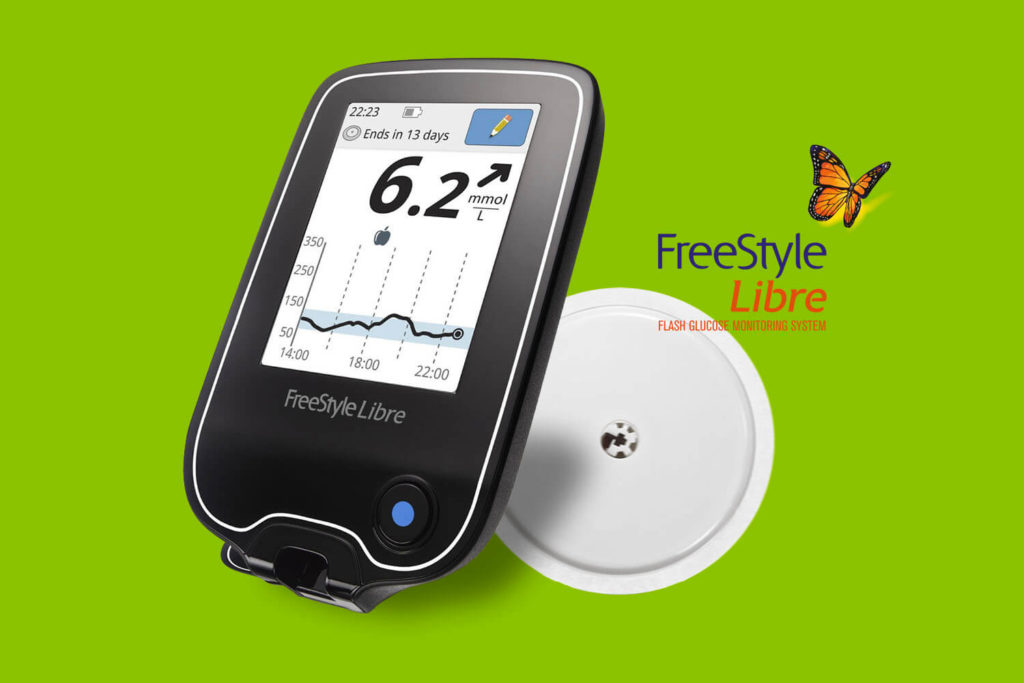It is an annoying process for many diabetes patients: measuring blood sugar with a finger prick. Sometimes up to 15 times a day! But fortunately, technology does not stand still. With a glucose sensor attached to the body, glucose levels can also be measured daily without finger pricks. And this is done using FGM or CGM. We explain what the difference is and we also provide a detailed explanation of how the popular Freestyle Libre glucose sensor works.
FGM (Flash Glucose Monitoring)
By using a glucose sensor it has become easier to measure glucose levels. One of the options is to scan the sensor yourself and keep track of the glucose values. This can be done using FGM, or Flash Glucose Monitoring. A sensor is applied to the upper arm or lower abdomen. It does not measure the glucose in the blood, but the interstitial fluid under the skin. This is the fluid in the structures between the body cells. These cells, among other things, extract glucose from the interstitial fluid. Because the blood is not measured immediately, the sensor has a delay of approximately 5 to 10 minutes. The results are collected by scanning the sensor with a scanner. The glucose values are then displayed on this device.
CGM (Continuous Glucose Monitoring)
CGM stands for Continuous Glucose Monitoring. CGM works in much the same way as FGM. The difference is that with CGM there is a transmitter in the sensor that continuously (every 5 minutes) transmits the glucose values to a receiver, such as a smartphone or insulin pump. Alarms can also be set to warn you if too high or too low glucose values are detected by the sensor. For example, the insulin pump can be automatically interrupted based on a low glucose value. However, CGM does require regular calibration. That is calibrating the equipment. The results are compared using a finger prick and the system can measure more accurately.

Does the basic package cover FGM and CGM?
The costs of using FGM are approximately 120 euros per month. The use of CGM is often three times as expensive as FGM. Under certain conditions, FGM and CGM are reimbursed from the basic package for certain groups of diabetes patients. Bee FGM This concerns those who often have to prick their fingers (at least 4 times a day) and follow intensive insulin therapy. CGM covers children up to the age of 18 with type 1 diabetes, pregnant women with type 1 diabetes, women who wish to have children and type 1 diabetes, type 1 diabetes patients with continuously high glucose levels and finally type 1 diabetes patients who have difficulty maintaining low glucose levels. see coming. Together with your doctor, it will be determined whether FGM or CGM has added value for your treatment.
Explanation of FGM device: Freestyle Libre
The Freestyle Libre as FGM is a popular tool for many diabetes patients. It is easy to use, less expensive than CGM, is reimbursed under less strict conditions and limits finger pricking. The equipment consists of:
- Scanner (allows you to set glucose target levels)
- A sensor (which is placed on the skin)
- A sensor applicator (to attach the sensor)
- Cleaning cloth and waste bin
Applying glucose sensor
Wash your hands and ensure that the area on the upper arm or abdomen is cleaned with the cloth and then dried. The cap of the sensor applicator is placed on the package containing the sensor. The sensor can then be attached to the arm or abdomen. The sensor can then be measured with the scanner after 24 hours.
The sensor lasts 2 weeks. 3 types of information are shown. That is the glucose measurement itself, a trend arrow and the values of the last 8 hours. The trend arrow shows the data of the last 15 minutes. Up and down slanted arrows indicate moderate fluctuations in glycemia (glucose levels). Arrows perpendicularly up or down indicate strong fluctuations. With a horizontal arrow the glycemia is constant. This data can then be shared with family members and doctors.
Sometimes there is an interruption in the data curve on the scanner. This may indicate too much time between two scans (8 hours), large fluctuations in glycemia or changes/differences over time. Sometimes the scanner reports that measurements can only be taken after 10 minutes. This can be caused by:
- Collision or contact with the sensor
- Too long contact with water (choose a water-resistant plaster for the sensor)
- Dehydration of the body, for example due to sunbathing for too long
- Recently injected insulin
- Large fluctuations in sugar content after a meal
When you receive this message, it is wise to measure the glucose level with a finger prick. In any case, you perform a finger prick if a high or low message is displayed on the scanner. If the message is still on the scanner after 24 hours, then you should consider replacing the sensor. Sometimes the sensor comes loose. This happens, for example, if a good place on the body has not been chosen. It is recommended to place the sensor on the outside of the upper arm on dry skin. For slim diabetic patients, this can also be done on the stomach. The use of FGM or CGM is always in consultation with a doctor. Do not make risky decisions without consulting your doctor.


Good afternoon,
I would like to order Freestyle Libre for one of my clients.
How do I do this?
Hello Anouk, we do not sell this product (anymore). It is best to check with Abbott about this. The insurer may reimburse.
Dear reader,
I have a question about the free style libre measuring device. I don't mean the sensor in your arm but the device where you can measure the blood sugar value via the free style libre. What is the price of this.
Would love to hear back.
Sincerely,
Odilia of the Deep